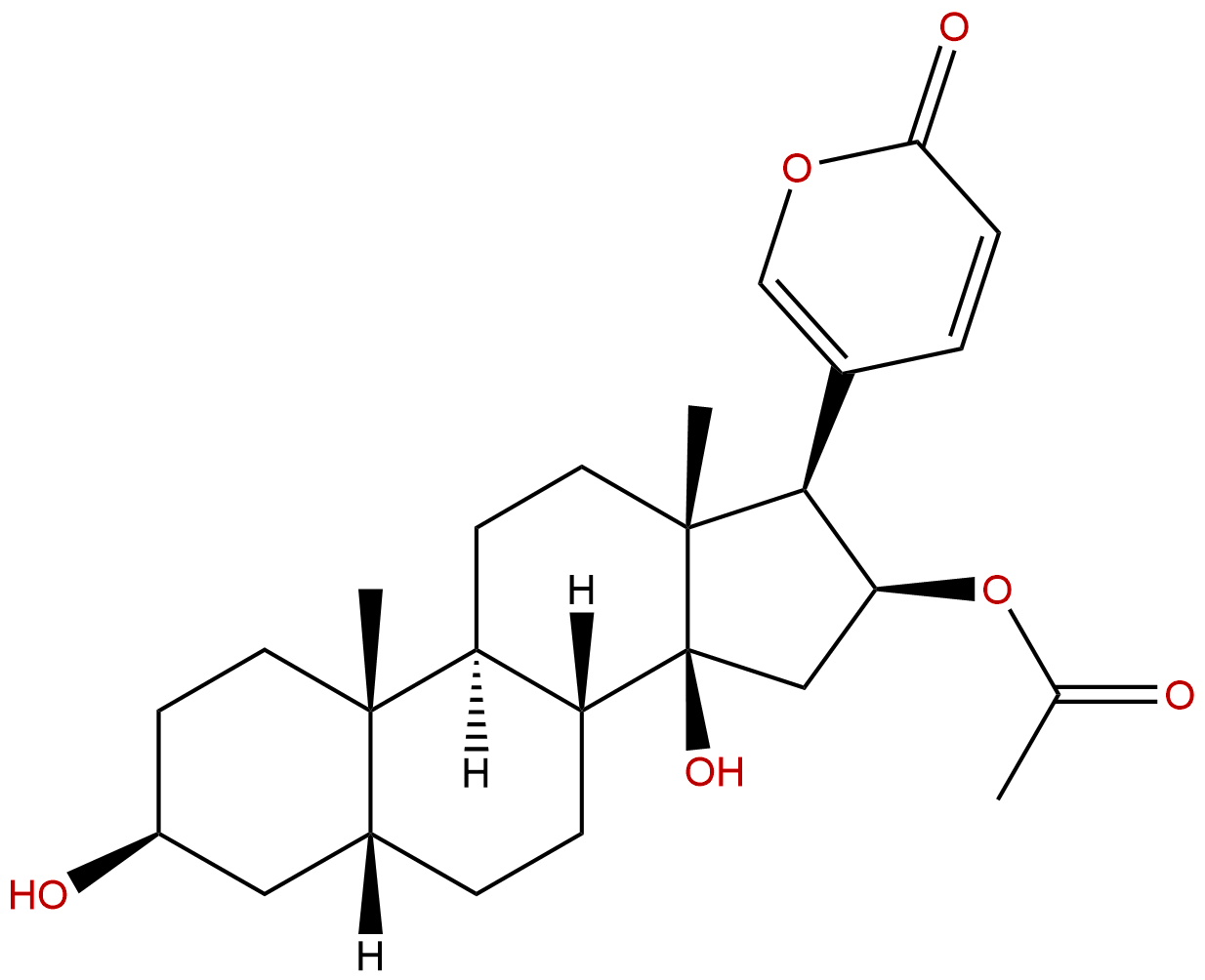
BufotalinCAS No.:471-95-4
|
||||||||||
 |
|
|
||||||||

| Catalogue No.: | BP0290 |
| Formula: | C26H36O6 |
| Mol Weight: | 444.568 |
Product name: Bufotalin
Synonym name: Bufotaline
Catalogue No.: BP0290
Cas No.: 471-95-4
Formula: C26H36O6
Mol Weight: 444.568
Botanical Source: Bufonis Venenum
Physical Description:
Type of Compound: Steroids
Purity: 95%~99%
Analysis Method: HPLC-DAD or/and HPLC-ELSD
Identification Method: Mass, NMR
Packing: Brown vial or HDPE plastic bottle
The product could be supplied from milligrams to grams
Inquire for bulk scale.
Description:
Bufotalin is a cardiotoxic bufanolide steroid, cardiac glycoside analogue. Bufotalin has anti-cancer activity, it can induce apoptosis in Hep 3B cells, and caspase-8 inhibitor (Z-IETD) or wide-ranging caspase inhibitor (Z-VAD) significantly suppresses the bufotalin-induced apoptosis. Bufotalin is a powerful sensitizer of death receptor-induced apoptosis in cancer cells, it promotes death receptor-mediated cell death, especially TRAIL-induced apoptosis, through activation of caspase-3 and PARP-1.
References:
J Agric Food Chem. 2009 Jan 14;57(1):55-61.
Involvement of caspases and apoptosis-inducing factor in bufotaline-induced apoptosis of Hep 3B cells.
Bufotaline is one of the bufadienolides isolated from Formosan Ch'an Su, which is made of the skin and parotid glands of toads. Ingestion of toad venom results in severe morbidity and high mortality. Although Ch'an Su is clinically toxic, it has been used as an important traditional Chinese medicine for heart failure and pains.
METHODS AND RESULTS:
In this study, Bufotaline-induced apoptosis in human hepatocellular carcinoma Hep 3B cells was investigated. The results indicate that externalization of phosphatidylserine, accumulation of sub-G(1) cells, fragmentation of DNA, and formation of apoptotic bodies were observed in bufotalin-treated Hep 3B cells. The signaling pathway might be via the activation of caspase-8, increase in mitochondrial tBid, disruption of mitochondrial membrane potential, and translocation of apoptosis-inducing factor (AIF). Active caspase-8 might activate caspase-9 and caspase-3 leading to the cleavage of nuclear PARP. Presence of AIF and cleaved PARP in the nuclei might lead to DNA fragmentation. Caspase-8 inhibitor (Z-IETD) or wide-ranging caspase inhibitor (Z-VAD) significantly suppressed the bufotalin-induced apoptosis, while the anti-Fas neutralization antibody had no effect.
CONCLUSIONS:
These data suggest that Bufotaline-induced apoptosis in Hep 3B cells might involve caspases and AIF.
Eur J Pharmacol. 2012 Oct 5;692(1-3):19-28.
Bufotaline from Venenum Bufonis inhibits growth of multidrug resistant HepG2 cells through G2/M cell cycle arrest and apoptosis.
Venenum Bufonis, a traditional Chinese medicine, is widely used in the treatment of liver cancer in modern Chinese medical practices.
METHODS AND RESULTS:
In our search for anti-hepatoma constituents in Venenum Bufonis, Bufotaline, bufalin, telocinobufagin and cinobufagin were obtained. Bufotaline was the most potent active compound among these four bufadienolides, and it exerted stronger inhibitory effect on the viability of doxorubicin-induced multidrug resistant liver cancer cells (R-HepG2) than that of their parent cells HepG2. Structure-activity relationship analysis indicated that the acetyl group linked to C-16 of bufadienolides might be useful for increasing anti-hepatoma activity. Further mechanistic studies revealed that Bufotaline treatment induced cell cycle arrest at G(2)/M phase through down-regulation of Aurora A, CDC25, CDK1, cyclin A and cyclin B1, as well as up-regulation of p53 and p21. Bufotalinetreatment also induced apoptosis which was accompanied by decrease in mitochondrial membrane potential, increases in intracellular calcium level and reactive oxygen species production, activations of caspase-9 and -3, cleavage of poly ADP-ribose polymerase (PARP) as well as changes in the expressions of bcl-2 and bax. It was also found that the inhibition of Akt expression and phosphorylation was involved in apoptosis induction, and specific Akt inhibitor LY294002 or siRNA targeting Akt can synergistically enhanced Bufotaline-induced apoptosis. In vivo study showed that Bufotaline significantly inhibited the growth of xenografted R-HepG2 cells, without body weight loss or marked toxicity towards the spleen.
CONCLUSIONS:
These results indicate that Bufotaline has a promising potential to become a novel anti-cancer agent for the treatment of liver cancer with multidrug resistance.
HPLC of Bufotalin
